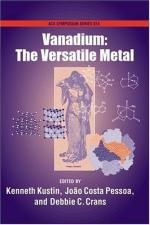|
This section contains 367 words (approx. 2 pages at 300 words per page) |
Vanadium is a transition metal in Group 5 and Row 4 of the periodic table. It has an atomic number of 23, an atomic mass of 50.9415, and a chemical symbol of V.
Properties
Vanadium is a silvery white, ductile, malleable metal with a melting point of about 3,450°F (1,900°C), a boiling point of 5,400°F (3,000°C), and a density of 6.11 grams per cubic centimeter. It is fairly inactive at room temperature, not reacting with oxygen, water, or most cold acids. It becomes more reactive at higher temperatures.
Occurrence and Extraction
Vanadium is relatively abundant in the Earth's crust, with an abundance estimated at about 100 parts per million. It is found in a number of minerals, including vanadinite, carnotite, roscoelite, and patronite. It is obtained commercially as a byproduct of the manufacture of iron since it is also present in most iron ores.
Discovery and Naming
Vanadium was "discovered" twice, the first time in 1801 by Spanish-Mexican metallurgist Andrés Manuel del Río (1764-1849). Del Río found the element for which he suggested the name panchromium, meaning "all colors." His colleagues in Europe were unable to confirm his discovery, however, and thought that del Río had mistaken chromium for a new element. About 30 years later, however, del Río's original findings were confirmed when Swedish chemist Nils Gabriel Sefström (1787-1845) rediscovered a new element in an ore of iron. He found that his "new element" was identical to the one del Río had reported three decades earlier. Sefström proposed the name vanadium for the element in honor of the Scandinavian goddess of love, Vanadis.
Uses
About 90% of the vanadium produced is used in steel alloys, to which it adds strength, toughness, and resistance to corrosion. Such alloys are often used in space vehicles and aircraft; in building and heavy construction equipment; and in transportation, machinery, and tools. Relatively small amounts of vanadium are used to make compounds with commercial applications, the most important of which is vanadium pentoxide (V2O5). Vanadium pentoxide is used as a catalyst in many industrial operations, as a coloring material for glass and ceramics, in the dyeing of textiles, and in batteries.
|
This section contains 367 words (approx. 2 pages at 300 words per page) |


